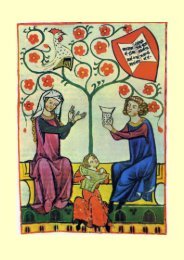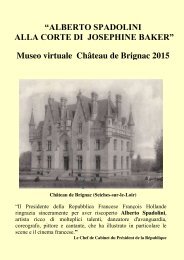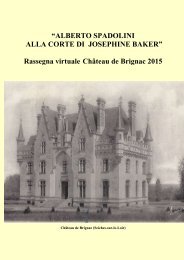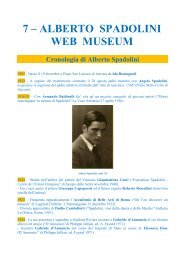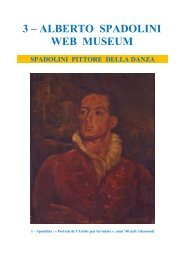Create successful ePaper yourself
Turn your PDF publications into a flip-book with our unique Google optimized e-Paper software.
THE IMAGINARY MUSEUM<br />
<strong>ALBERTO</strong> <strong>SPADOLINI</strong><br />
<strong>AT</strong> <strong>JOSEPHINE</strong> <strong>BAKER’S</strong> <strong>COURT</strong><br />
<strong>Château</strong> <strong>de</strong> <strong>Brignac</strong> <strong>2015</strong><br />
The Castle of <strong>Brignac</strong> (Seiches-sur-le-Loir)<br />
Translation: Rosella Simonari
First floor<br />
Spadolini insi<strong>de</strong> the Castle, 1950s (P. Oger Collection)<br />
Le danseur Spadolini & Joséphine Baker<br />
“Paris still remembers the night it discovered Spadolini” ,<br />
runs one of them. “It was at one of Josephine Baker’s<br />
revues. To the music of Cimarosa’s Secret Marriage,<br />
against a background that looked vaguely Chinese,<br />
Spadolini emerged as though from some eighteenthcentury<br />
painting, together with Josephine, dressed as a<br />
Creole marquise. It was a marvellous sight, greeted with<br />
enthusiasm by le tout Paris.”<br />
Article published in Paris, 1940s
Studio Piaz: «Joséphine et Spadolini» 1932 (Mei Collection)
Spadolini, 1933<br />
“There was a group of friends at the Casino <strong>de</strong> Paris,<br />
including the naked dancer Spadolini – although, on this<br />
particular occasion, he was clothed,” wrote Josephine<br />
Baker in her Memoirs, compiled in 1935 by the writer<br />
André Rivollet.<br />
It is no coinci<strong>de</strong>nce that Rivollet should have singled out<br />
Spadolini for mention at the beginning of these ‘Memoirs’.<br />
The two dancers were inseparable, on stage and off, in the<br />
show at the Casino <strong>de</strong> Paris, and in the tours of Europe.<br />
Rosella Simonari “In Search of Alberto Spadolini”,<br />
Ballet-Dance Magazine 2006
Condé Nast: «Joséphine Baker» 1930s
Joséphine Baker: «Theater <strong>de</strong>s Westens – Nachtkabarett », 1920s<br />
Josephine Baker herself tells us of her secret war: enrolled by the<br />
French secret services as the Second World War broke out, she is<br />
given the task of bringing information of vital importance<br />
transcribed on the music sheet with invisible ink: “…she is<br />
thought to have transferred to Portugal all the information gained<br />
on the German army in the east of France. The information<br />
inclu<strong>de</strong>d location of air bases, harbours and landing crafts. The<br />
information was related to a possible attack against Gibraltar…and<br />
to the expected landing in November 1940 of Abwehr II’s agents<br />
on the Welsh coast.”
Joséphine Baker, 1920s
Fe<strong>de</strong>rico Fellini: «Joséphine Baker» (courtesy of Vincenzo Mollica)<br />
His encounter with Josephine Baker was as magical as his <strong>de</strong>but in the<br />
dance world, and it is recounted by the Flemish magazine “De Dag”.<br />
She was looking for a new partner in her shows, and when she saw<br />
Spadolini performing, she chose him to dance with her at the Paris<br />
Casino. As some newspapers articles ironically un<strong>de</strong>rlined, Baker was<br />
looking for a dancer and she had found a painter. Between 1932 and<br />
1935, Spado’, as he was called, and Baker performed together in<br />
several shows such as “La Joie <strong>de</strong> Paris”, “Hawaii” and “Créole”.<br />
Rosella Simonari “In Search of Alberto Spadolini”,<br />
Ballet-Dance Magazine 2006
«Spadolini» Gerval paper mill, Belgium, 1930s
Spadolini and Joséphine Baker in a drawing by Pierre Payen, Casino <strong>de</strong> Paris, 1933<br />
“When Spadolini ma<strong>de</strong> his appearance as Josephine<br />
Baker’s new partner, many people saw it as a revelation.<br />
Though ‘partner’, perhaps, is not really quite the word: in<br />
part because he is at his finest when he dances alone, drunk<br />
on his own particular genius.”<br />
Jean Barois, Paris Midi, 1933
Paul Colin : «La Revue Nègre », 1927
Spadolini: «Casino <strong>de</strong> Paris», 1933<br />
VARIETY NEW YORK - 27 December 1932<br />
“Revue du Casino <strong>de</strong> Paris. Outstanding factor in the Revue<br />
in Spadolini a male dancer. He’s absolute Knock-out here<br />
and got repeated ovations.”
Jean-Gabriel Domergue: «Joséphine Baker», 1936
Spadolini et Joséphine Baker: «Les Folies du Music-Hall», Jacques Damase, 1960<br />
“In 1931 we find Spadolini in the French Riviera: paintsmeared<br />
and sweat-soaked, he was painting the set for a<br />
dance hall when, all of a sud<strong>de</strong>n, he began to dance as if he<br />
had been possessed by a divine power. He abandons<br />
paintbrush and palette and becomes “Premier Danseur <strong>de</strong><br />
l’Opéra <strong>de</strong> Monte Carlo”. He is acclaimed as the new<br />
Nijinsky, performs with Mistinguett and Serge Lifar, makes<br />
Picasso jealous of him, runs away with Jean Renoir’s wife,<br />
but does not disdain to appear in charity shows to honour<br />
the Garibaldini from Argonne and the War Mutilated and<br />
Crosses.”<br />
Bolero-Spadò 2007
Joe Pazen: «Spadolini», Palais <strong>de</strong> Chaillot, Paris, 1946
Ve<strong>de</strong>ttes, Paris, 1941<br />
Alberto Spadolini, here portrayed among international dance<br />
stars, has been <strong>de</strong>fined: “…a man supported by secrets!” by<br />
director Anton Giulio Bragaglia.
Photo Cayeb: « Spadolini », Bruxelles, 1930s
The Dancing Time: «Spadolini at the Prince Edward Theatre», 1934<br />
LONDON (THE ERA) - 3 March 1934<br />
“Spadolini, scores in an international dancing act of<br />
distinct merit.”
Spadolini & Tatiana Riabouchinska, 1930s
Vogue: «Spadolini, the dancer and his shadow», photo Hoyningen-Huené, 1933<br />
VOGUE - April 1933<br />
“Spadolini … He has brilliant technique and great beauty<br />
of movement and pose …”
Studio Piaz: «Spadolini», Paris 1932
Illustrated: «Spadolini, Apollo of the Dance», 1947<br />
ILLUSTR<strong>AT</strong>ED – LONDON September 1947<br />
“Spadolini appeared at the London Casino in 1938, and Britain<br />
will see him again on television with the ‘London Ballet<br />
Company’ during the coming winter. He has been called the<br />
‘Apollo of the Dance’, and likened to Nijinsky, the great Russian<br />
dancer. He fills theatres in Paris, New York and South America.<br />
He is doubly an artist for, after his dawn practice, he retires to his<br />
Montmartre studio and becomes a painter.”
Condé Nast : «Spadolini», Casino <strong>de</strong> Paris, 1933
Harry Meerson: «Bolero-Spado», Paris, 1930s<br />
CHICAGO III. DAILY - 14 December 1934<br />
“Spadolini, an Adonisian poseur.”
Spadolini: «Casanova», 1930s (Pierre Barlatier De Mas collection)
Maurice Seymour: «Spadolini », Chicago, 1935<br />
BOSTON DAILY RECORD - April 1935<br />
“Spadolini, is a sensational novelty … such as you will<br />
seldom see on an American stage.”
Studio Piaz: «Spadolini», Paris, 1932
Photo Cayeb: «Spadolini», Bruxelles, 1930s<br />
STERN (VARIETY NEW YORK) - 4 December 1935<br />
“Spadolini, who combines a remarkable body with real<br />
dancing ability does an excellent number.”
Studio Roger Carlet: «Spadolini», Paris, 1930s
Spadolini, 1930s (Pierre Barlatier De Mas collection)<br />
THE NEW YOR TIMES – 5 July 1936<br />
“Spadolini, a young Italian dancer, is reported as having<br />
achieved renown at the Royal Opera, Rome, and the Casino<br />
<strong>de</strong> Paris. His New York début recital is to be ma<strong>de</strong> up of<br />
excerpts from various Italian ballets, and such in<strong>de</strong>pen<strong>de</strong>nt<br />
items as a mo<strong>de</strong>rn machinery number ‘Toscanini’ and<br />
‘Chinese Opium Smoker’.”
Studio Piaz: «Spadolini», 1930s
Condé Nast: «Spadolini», Casino <strong>de</strong> Paris, 1933<br />
THE AMERICAN DANCER – 1938<br />
“The American Premiere of the ‘Paris Exposition Ballets’<br />
with Spadolini, dancer and choreographer of the Monte<br />
Carlo Opera, will be staged in Los Angeles for three<br />
performances in January. Spadolini brought here un<strong>de</strong>r<br />
contract to MGM, will bring his principal dancers,<br />
costumers and orchestrations from Paris.”
Spadolini: «Le Martyre <strong>de</strong> Saint-Sébastien»,1930s
Studio Piaz: «Spadolini», Paris, 1933<br />
“My friends think I am mad because I prefer contracts that<br />
allow me to travel and experiment all the arts instead of<br />
those that pay me a lot of money. Money has never<br />
interested me!”<br />
Alberto Spadolini
Maurice Seymour: «Hermes - Spadolini», Chicago, 1935
Corbellini: «Le danseur Spadolini», 1939 (Pierre Barlatier De Mas collection)<br />
“Spadolini personnifies a poet’s dream.”<br />
Max Jacob
Photo Cayeb: «Spadolini», Bruxelles, 1930s
Spadolini and Nati Morales, Paris, 1933<br />
DANCE MAGAZINE – 1947<br />
“Spadolini back from the United States and ‘en route’ to<br />
South America, danced Ravel’s Bolero for the 200 th time<br />
at the Palais <strong>de</strong> Chaillot this month.”
Photo Roger Carlet: «Spadolini danse menuet <strong>de</strong> Lulli», 1930s
Spadolini and princess Leila Be<strong>de</strong>rkhan, Palais <strong>de</strong> Chaillot, 1949<br />
“At the Palais <strong>de</strong> Chaillot in Paris, Spadolini performs with an<br />
exceptional exotic dancer, Kurdish princess Leila Be<strong>de</strong>rkhan. As the<br />
New York Times highlights, a series of homici<strong>de</strong>s and various<br />
mysterious <strong>de</strong>aths transformed Leila in the last heiress of the<br />
Be<strong>de</strong>rkhan’s dynasty. Precisely because of her religious dances, that,<br />
according to some fanatics, represent a true profanation, Leila receives<br />
<strong>de</strong>ath threats from Istanbul, Cairo and Kurdistan.”
Spadolini and Yvette Bouland, 1930s
Second floor<br />
Countess Yvette <strong>de</strong> Marguerie insi<strong>de</strong> the Castle of <strong>Brignac</strong> (P. Oger collection)<br />
Spadolini was a painter, a <strong>de</strong>corator, a sculptor,<br />
an illustrator, a restorer, an actor, a director, a singer…<br />
“Alberto Spadolini begins his activity as set <strong>de</strong>signer assistant<br />
and painter at the ‘Teatro <strong>de</strong>gli Indipen<strong>de</strong>nti’ in Rome, a meeting<br />
venue for the Italian artistic vanguards, where artists and<br />
intellectuals like Giorgio De Chirico and Filippo Tommaso<br />
Marinetti often met. At the end of the 1920s the Theatre closed for<br />
pressing financial problems and Benito Mussolini’s pressure, as he<br />
badly tolerated that group of young people who had nicknamed<br />
him ‘the violinist’.”
Spadolini: «Portrait <strong>de</strong> l’Artiste par lui-même», 1940s (Ghassoul collection)<br />
“Mythological, mystical and fawnous! Visions of Spadolini.”<br />
Paul Valéry
Spadolini: «Étoiles <strong>de</strong> l’Opéra n.1», 1950s<br />
“Spadolini’s pictorial research is the transfiguration of the soul<br />
of dance which expresses the profound vibration of his<br />
characters, portrayed through synthesis and the emotional<br />
inspiration of the moving bodies. This artist truly works on this<br />
matter taking inspiration from the sensitive universe,<br />
transforming it with his genius that comes from his heart and<br />
soul”.<br />
Jean Cocteau
Spadolini: «Le Jongleur», 1940s
Spadolini: «Satyricon», 1960s<br />
“Nature imitates Art” used to say Oscar Wild. Is not painter<br />
Spadolini the marvellous juggler who calls upon our curiosity,<br />
excites our sensibility, thus revealing that which only ve could<br />
not perceive? In his compositions, Spadolini carries us away<br />
with him to his discoveries and reveals to us our own Universe.<br />
He will have <strong>de</strong>livered us as <strong>de</strong>livers himself.<br />
Prince Felix Youssoupoff
Spadolini: «Le Visage <strong>de</strong> l’amour», 1940s
Spadolini: « Variation romantique », 1960<br />
“Once more this year, I find again with pleasure Alberto<br />
Spadolini, whom I knew as a stu<strong>de</strong>nt of Vlaminck and Derain, at<br />
the Salon <strong>de</strong>s Indépendants, ‘where his art becomes a magical<br />
conscious dream, where reality is transfigured by rapture …<br />
where to un<strong>de</strong>rstand is to limit the object, where to guess is to<br />
discover its extension’, as he himself expressed it!”<br />
Marcel Rouault, “La Semaine à Paris” 1972
Spadolini: «Duilio, la première leçon <strong>de</strong> danse», 1947 (P. Oger collection)
Spadolini: «Séréna<strong>de</strong> <strong>de</strong> Schubert», 1960 (Mario Spa<strong>de</strong>llini collection)<br />
Interestingly, he created a whole series of paintings inspired by<br />
ballet, with fluctuating ballerinas in white long tutus surroun<strong>de</strong>d<br />
by curtains whose sha<strong>de</strong>s of light and darkness followed those of<br />
the costumes. This topic is very significant with respect to the<br />
kind of dancing he performed. He was a music-hall dancer, but<br />
from his paintings it seems that his aspiration or his i<strong>de</strong>al of dance<br />
was ballet, and precisely, Romantic ballet.<br />
Rosella Simonari “In Search of Alberto Spadolini”,<br />
Ballet-Dance Magazine 2006
Spadolini: «Charlotte Bara», 1972 (Conti collection)
Spadolini: «Groupe dansant», 1950s (Mario Spa<strong>de</strong>llini collection)
Alberto Spadolini and Liane Daydé insi<strong>de</strong> Volinine’s studio, Paris, 1950s
Spadolini: «Lungo la Senna, in lontananza Notre-Dame», 1965<br />
“Nevertheless, Spadolini’s success continued both as dancer<br />
and painter. Wherever he was touring, he also tried to find a<br />
place to exhibit his paintings, and even when he no longer<br />
danced, he continued to expose his work. We have a record of<br />
an exhibition he organised in Brussels at the Galerie Rubens in<br />
1955, titled “La Danse”, probably featuring his dance series<br />
paintings<br />
Rosella Simonari “In Search of Alberto Spadolini”,<br />
Ballet-Dance Magazine 2006<br />
.
Spadolini: «Notre-Dame <strong>de</strong> Paris», 1940s
Spadolini: «Place Vendôme» Paris, 1950 (Andrée Lotey collection)
Spadolini: «Sacré-Coeur», Paris, 1949 (Andrée Lotey collection)
Spadolini: «Splen<strong>de</strong>urs <strong>de</strong> la mer», 1950s<br />
Spadolini had left his hometown, Ancona, to go to Rome and study<br />
as painter. After <strong>de</strong>buting in the studio of Vatican painter Gian<br />
Battista Conti, he joined the Bragaglia group and began to expose his<br />
work and create his own set <strong>de</strong>sign pieces .. He liked painting the<br />
natural landscapes of Marche with its nice hills and countrysi<strong>de</strong>,<br />
towns such as Ancona, and dancers. He was a figurative painter who<br />
was more inspired by Venetian artist Canaletto rather than Futurist<br />
painter Balla.<br />
Rosella Simonari “In Search of Alberto Spadolini”,<br />
Ballet-Dance Magazine 2006
Spadolini: «Ida Romagnoli Spadolini», 1960s
Spadolini: «Fermo», 1950s (Stefano Travaglini collection)<br />
Spadolini: «Campagne <strong>de</strong>s Marches», 1954
Spadolini: «Fleurs n. 2», 1950s
Spadolini Exhibitions: Paris, Luxembourg, Bruxelles, Stockolm<br />
“Spadolini was familiar with various people in the diplomatic<br />
world: at the 1955 vernissage, organised in occasion of the<br />
exhibition sponsored by his friend, prince Felix Yussupov at the<br />
‘Galerie Bradtké’ in Luxembourg, a lot of important people took<br />
part: Pierre-Alfred Saffroy, French plenipotentiary ambassador,<br />
and the representatives from the <strong>de</strong>legation of the United States,<br />
Great Britain and Italy.”
Spadolini: «Venise», 1940s
Spadolini: «Fontaine <strong>de</strong> la Vie - décoration du <strong>Château</strong> <strong>de</strong> <strong>Brignac</strong>» (E. Duval collection)<br />
“Spadolini begins a relationship with countess Yvette <strong>de</strong> Marguerie<br />
owner of <strong>Brignac</strong>’s Castle, active member of the ‘Mouvement National<br />
<strong>de</strong>s Croix <strong>de</strong> Lorraine’, Charles De Gaulle’s anti-Nazi society. In this<br />
small provincial castle important figures from the aristocracy and<br />
international politics come, like the Russian prince Felix Yussupov and<br />
princess Irina, the duke and duchess of Windsor, the Prime Minister<br />
Giovanni Spadolini (who was distantly related to Spado’), André<br />
Malraux, one of the great French intellectuals, repeatedly elected<br />
Minister and a trustworthy man for De Gaulle.”
Spadolini: «Sculptures: Hands», 1950s
Spadolini: «Les Sources <strong>de</strong> l’Orgueil», 1952
Spadolini: «Libre arbitre», 1957
«Détail du tableau Marie-Ma<strong>de</strong>leine» restored by Spadolini in the 1940s<br />
« Spadolini worked as a restorer in the Paris studio of Jules<br />
Boucher »<br />
Bolero-Spadò, 2007
Bartolomé Esteban Murillo School: «Saint-Antoine <strong>de</strong> Padoue et l’Enfant Jésus»,<br />
restored by Spadolini, 1940s
Spadolini: “Le jour se léve”, 1939<br />
« Spadolini acted with Jean Gabin and Jean Marais… »<br />
Bolero-Spadò, 2007
Spadolini: “Marinella”, 1936
Spadolini: «Nous les Gitans», 1951 (Cinémathèque française collection)<br />
At the beginning of the 1950s Spadolini worked as director<br />
of some documentaries, among whom there are, “Rivage <strong>de</strong><br />
Paris” featuring gypsy guitar player Django Reinhardt;<br />
“Souvenirs d’Espagne” featuring flamenco dancer and<br />
singer Carmen Amaya; “Nous le gitans”, shot in Andalusia.
Spadolini : « Nous les Gitans », 1951
Léoni<strong>de</strong> Massine: «Tales of Hoffmann», London Film, 1951<br />
“Spadolini … adapter of dialogues for the London Film (the film<br />
“The Tales of Hoffmann” with Massine and Tchérina received<br />
an award at the Cannes Film Festival in 1951), short film director<br />
and scriptwriter with Carmen Amaya, Django Reinhardt, Suzy<br />
Solidor ...”
Photo Hartcourt : « Le chanteur Spadolini »<br />
“Spadolini possesses the sense of the mo<strong>de</strong>rn so rare on the<br />
stage and yet so rich in possibilities. Besi<strong>de</strong>s he also sings in an<br />
agreeable and good voice and possesses the diversity of gifts the<br />
Music-Hall requires.”<br />
Petit Parisien
Third floor<br />
«Spadolini», 1930s<br />
Le mon<strong>de</strong> fantastique <strong>de</strong> Spadolini<br />
“Here a once legendary figure emerges from unfair oblivion<br />
to strike again. He is Alberto Spadolini an Italian dancer who<br />
cut a dash in the Paris of the ‘gol<strong>de</strong>n years’ alongsi<strong>de</strong> muses<br />
such as Mistinguett and Josephine Baker, and intellectuals<br />
such as Jean Cocteau and Jean Marais, offering his perfect,<br />
athletic nakedness to the public and earning the nickname<br />
‘the living Rodin’.”<br />
Franco Maria Ricci, 2007
Alberto Spadolini: «Yvette <strong>de</strong> Marguerie», <strong>Château</strong> di <strong>Brignac</strong>, 1950s
Notre Cœur, « Prince Charmant», Paris 1941
Paris, 14 July 1937<br />
Spadolini, Suzy Solidor, Marianne Oswald, Raoul Guérin (Canard Enchainé), 1930s
Corbellini: «Spadolini», 1940s (Corbellini collection)<br />
Spadolini is involved in the anti-Nazi Resistance too. In an<br />
article published in 2007, Jean-François Crance remembers<br />
“…his war [was] generous, dangerous, reckless!”
Bérard: «Brochure Ballets Russes», 1937
Henri Matisse: “Brochure Ballet Russe <strong>de</strong> Monte Carlo”, 1938
Jean Cocteau: “Brochure La danse à travers les âges », 1945
Enrique Juvet: « Bolero-Spado », Paris 1933
Zig : «Brochure Casino <strong>de</strong> Paris », 1931
Brochure «Ballet Russe <strong>de</strong> Monte Carlo», 1940
Paul Colin «Brochure La Joie <strong>de</strong> Paris» with Joséphin Baker and Spadolini, 1932 – 1933
Picasso: «Picasso with nu<strong>de</strong> Dora Maar», lithograph n. 62, Suite Vollard, 1956<br />
Picasso: «Minotaur with Dora Maar», lithograph n. 83, Suite Vollard, 1956
Dora Maar: «Spadolini», Paris, 1935
Marlène Dietrich, 1930s<br />
“Spadolini, if I had been a dancer, it is you that I would have<br />
wanted as my partner.”<br />
Marlène Dietrich
Photo Piaz: Mistinguett
Advertisment for the cabaret, Chez Spadolini – l’Amiral, 1948 (P. Oger collection)<br />
“Spadolini is commonly called the Apollo of dancing. He has<br />
conquered Paris, New York and the big cities in South<br />
America. His lodgings are in Montmartre. In or<strong>de</strong>r for him to<br />
train, the French authorities have let him use the Palais <strong>de</strong><br />
Chaillot along the Seine, near the Eiffel Tower. After Serge<br />
Lifar’s fall into disfavour, due to his performance for Hitler’s<br />
troops during the German occupation of France, Spadolini is<br />
now consi<strong>de</strong>red the number one …”.
Spadolini : «Meillers voeux», 1950s (Mei collection)
Joe Pazen: «Spadolini danseur et peintre», Parigi, 1946 (Bua<strong>de</strong>s collection)<br />
The Italian journalist Cristiano Lovatelli Ravarino let us know about<br />
an interesting exchange he had with the head of Intelligence Hugh<br />
Montgomery<br />
“…Years ago Hugh Montgomery – maybe the brightest head of<br />
Intelligence I have ever met - asked me if the agent Spadolini was a<br />
relative of the Italian Prime Minister Giovanni Spadolini … I<br />
answered that I had no information on the matter.<br />
“Is he still in the field?”<br />
“Honestly, I have never heard about such an agent…” I observed.<br />
“Brilliant!”<br />
“What do you mean, brilliant?”<br />
“I mean brilliant Spadolini: the best agent is the one whose existence<br />
you can’t even guess.”
Joe Pazen: «Spadolini danseur et peintre», Parigi 1946 (Pierre Barlatier De Mas collection)
Last photographic image of Alberto Spadolini, autumn 1972 (C. Petix collection)<br />
Recently some photographs arrived from France, portraying<br />
Alberto Spadolini in 1972, the year he died. He poses as if he<br />
were playing the role of a … spy. In the first photograph his long<br />
white dress and sunglasses recall Lawrence d’Arabia. In the<br />
second, he wears an elegant suit, expressing a heroic and ironic<br />
glance. In the third one he is about to open a door, his eyes once<br />
again hid<strong>de</strong>n by turbid sunglasses…with Spadolini nothing<br />
happens by chance !
Spadolini, <strong>Château</strong> <strong>de</strong> <strong>Brignac</strong>, 1950s (P. Oger collection)<br />
“Spadolini, ambassador of Italian art in the world, with his<br />
luggage and a cigarette eternally lit on his mouth, in the act<br />
of leaving for a new adventure.”
IN THE CASTLE PARK<br />
Concert «La Joie <strong>de</strong> Paris»<br />
“Nicoletta Fabbri Quintet”<br />
Spadolini: «<strong>Château</strong> <strong>de</strong> <strong>Brignac</strong>», 1950s (P. Oger collection)
Nicoletta Fabbri: «Sous le ciel <strong>de</strong> Paris», 2014<br />
https://www.youtube.com/watch?feature=player_embed<strong>de</strong>d&v=ZzIyB2baNvM<br />
NICOLETTA FABBRI voice<br />
STEFANO TRAVAGLINI bass and double bass<br />
ROBERTO STEFANELLI piano<br />
GABRIELE ZANCHINI accordion<br />
ROBERTO MONTI guitar<br />
www.albertospadolini.it




